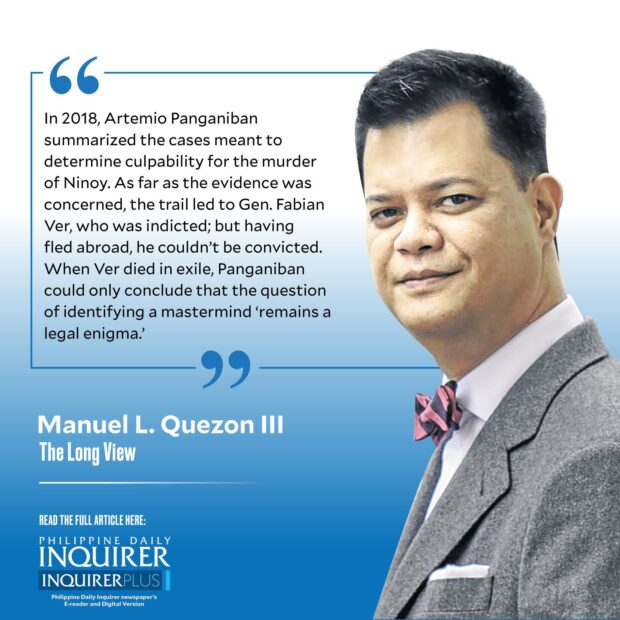Mastermind
 Last Monday’s 40th anniversary of Benigno “Ninoy” Aquino Jr.’s murder was accompanied by the usual “Who is the mastermind?” chorus. As I said in a 2017 commentary, clarity is impossible because of the confused situation the Philippines was in back in 1983. Ninoy had decided, in May, to return by Aug. 7, 1983, to prepare in turn, for elections in 1984. A charitable reading of events would place the great dictator and his wife in the place of King Henry II of England who (in)famously ranted, “Will no one rid me of this troublesome priest?” This rhetorical question was taken literally by eager courtiers who assassinated Archbishop Thomas Becket.
Last Monday’s 40th anniversary of Benigno “Ninoy” Aquino Jr.’s murder was accompanied by the usual “Who is the mastermind?” chorus. As I said in a 2017 commentary, clarity is impossible because of the confused situation the Philippines was in back in 1983. Ninoy had decided, in May, to return by Aug. 7, 1983, to prepare in turn, for elections in 1984. A charitable reading of events would place the great dictator and his wife in the place of King Henry II of England who (in)famously ranted, “Will no one rid me of this troublesome priest?” This rhetorical question was taken literally by eager courtiers who assassinated Archbishop Thomas Becket.
In 2018, Artemio Panganiban summarized the cases meant to determine culpability for the murder of Ninoy. As far as the evidence was concerned, the trail led to Gen. Fabian Ver, who was indicted; but having fled abroad, he couldn’t be convicted. When Ver died in exile, Panganiban could only conclude that the question of identifying a mastermind “remains a legal enigma.”
The Cambridge Dictionary’s definition of a mastermind is “someone who plans a difficult activity, often a crime, in detail and makes certain that it happens successfully.” Ver, in avoiding trial, not only saved himself from being sentenced, he permanently made it impossible to find out if he was acting upon instructions. Let me add that enough time passed, from the murder to the fall of the Marcoses, for the trail to go permanently cold, even before they went into exile. And Ferdinand Marcos was the mastermind of this.
Marcos could have—should have—sacrificed his rooks, the generals in charge of security at the airport. But absolute power means absolute responsibility; to be all-powerful is to be all-knowing. As Marcos himself told an American journalist on Sept. 9, 1983: “I am convinced that if any member of my government were involved, I would have known somehow … Even at a fairly low level, I would have known. I know how they think. I know what they are thinking of.”
He wasn’t shy about suggesting what the acceptable finding should be. Here he is, eight months later, in May 1984, talking to CBS: “What you have been reading are the newspapers and the newspaper reports have been biased. The evidence still proves that Galman was the killer. The evidence also shows that there were intelligence reports connecting the communist party to the killing.”
But not to the commission he created. Reviewing events in 1986, the late Chief Justice Claudio Teehankee wrote that what the majority and minority reports of the Agrava Board had in common was a rejection of the military’s assertion that Rolando Galman was the assassin. All agreed that instead, there’d been a military conspiracy. The difference, he wrote, lay in the majority going up to the level of Ver as far as the 26 individuals it found culpable, while Corazon Agrava herself only went as far as the six soldiers actually on the service stairs plus Gen. Luther Custodio.
A charitable reading absolving Marcos and Imelda hinges on the plot being hatched when the dictator was out of commission because he had just gotten a new kidney, donated by his son.
Teodoro M. Locsin, who knew Marcos well, wrote Marcos had a military mind and must have considered assassination as one option as he evaluated the implications of Ninoy’s return.
This evaluation didn’t take place in August, it had to take place in May. Three warnings, from Imelda on May 21; Marcos himself on July 19; and Juan Ponce Enrile on July 31, came came from the ruling couple themselves and one of their principal lieutenants. While escalating warnings, Ver’s authority was also escalated.
On Aug. 1, as Marcos prepared to “go into seclusion to write a book” (the transplant) he announced that control over the Philippine National Police would be taken away from Fidel V. Ramos and given to Ver.
A week before Ninoy’s arrival, Marcos announced he’d confirmed the sentence of death by musketry imposed by a military tribunal on Ninoy six years earlier.
On Aug. 20, Ninoy got a phone call from Manila and reveals to reporters he was told he might be assassinated at the Manila International Airport but that the soldiers would, in turn, hit the hitman.
By Aug. 21, early in the morning: Ver instructed Custodio to “arrest Aquino and turn him over to the Military Security Command in Fort Bonifacio.”
Marcos thus had no choice but to acquit all, and not just some, of those accused of murdering Ninoy. That he did so, is not an opinion, but a fact recognized as such by the Supreme Court, when it ordered the Sandiganbayan to conduct a retrial. Late Justice Amuerfina Melencio-Herrera pointed out that the strategy in the original Sandiganbayan trial was to inoculate the accused: by fixing the trial, the principle of double jeopardy would keep them from being held to account through future proceedings. To be selective would be an invitation to squeal.
For Marcos to sacrifice his generals would have been to sacrifice himself. This makes the mastermind question academic. By saving Ver, the highest suspect, he took ownership of the conspiracy even if he wasn’t the mastermind all along.